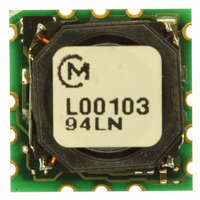OKL-T/3-W12N-C Murata Power Solutions Inc, OKL-T/3-W12N-C Datasheet - Page 17

OKL-T/3-W12N-C
Manufacturer Part Number
OKL-T/3-W12N-C
Description
CONV DC/DC 15W 12VIN 3AOUT SMD
Manufacturer
Murata Power Solutions Inc
Series
Okami™ OKL-T/3-W12r
Type
Point of Load (POL) Non-Isolatedr
Specifications of OKL-T/3-W12N-C
Number Of Outputs
1
Output
0.59 ~ 5.5V
Power (watts)
15W
Mounting Type
Surface Mount
Voltage - Input
4.5 ~ 14V
Package / Case
12-SMD Module
1st Output
0.59 ~ 5.5 VDC @ 3A
Size / Dimension
0.48" L x 0.48" W x 0.25" H (12.2mm x 12.2mm x 6.4mm)
Power (watts) - Rated
15W
Operating Temperature
-40°C ~ 85°C
Efficiency
93%
Approvals
EN, UL
Output Power
17 W
Input Voltage Range
4.5 V to 14 V
Input Voltage (nominal)
12 V
Output Voltage (channel 1)
0.591 V to 5.5 V
Output Current (channel 1)
3 A
Output Type
Adjustable Output DC/DC Converters
Output Voltage
0.591 V to 5.5 V
Product
Non-Isolated / POL
Lead Free Status / RoHS Status
Lead free / RoHS Compliant
3rd Output
-
2nd Output
-
Lead Free Status / Rohs Status
Lead free / RoHS Compliant
Other names
811-2072-2
Available stocks
Company
Part Number
Manufacturer
Quantity
Price
Output Current Limiting
Current limiting inception is defi ned as the point at which full power falls
below the rated tolerance. See the Performance/Functional Specifi ca-
tions. Note particularly that the output current may briefl y rise above its
rated value in normal operation as long as the average output power is
not exceeded. This enhances reliability and continued operation of your
application. If the output current is too high, the converter will enter the
short circuit condition.
Output Short Circuit Condition
When a converter is in current-limit mode, the output voltage will drop as
the output current demand increases. If the output voltage drops too low
(approximately 98% of nominal output voltage for most models), the mag-
netically coupled voltage used to develop PWM bias voltage will also drop,
thereby shutting down the PWM controller. Following a time-out period, the
PWM will restart, causing the output voltage to begin rising to its appropri-
ate value. If the short-circuit condition persists, another shutdown cycle
will initiate. This rapid on/off cycling is called “hiccup mode”. The hiccup
cycling reduces the average output current, thereby preventing excessive
internal temperatures and/or component damage.
because you do not have to power down the converter to make it restart.
The system will automatically restore operation as soon as the short circuit
condition is removed.
Remote On/Off Control
The remote On/Off Control can be specifi ed with either positive or negative
logic polarity. Please refer to the Connection Diagram on page 1 for On/Off
connections.
is pulled high to +Vin with respect to –Vin. An internal bias current causes
the open pin to rise to +Vin. Positive-polarity devices are disabled when the
On/Off is grounded or brought to within a low voltage (see Specifi cations)
with respect to –Vin.
brought to within a low voltage (see Specifi cations) with respect to –Vin.
The device is off (disabled) when the On/Off is pulled high with respect to
–Vin (see specifi cations).
fi ed signal current when brought low and withstand appropriate voltage
when brought high. Be aware too that there is a fi nite time in milliseconds
(see Specifi cations) between the time of On/Off Control activation and
stable, regulated output. This time will vary slightly with output load type
and current and input conditions.
Output Capacitive Load
rated specifi cations. Users should only consider adding capacitance to
reduce switching noise and/or to handle spike current load steps. Install
only enough capacitance to achieve noise objectives. Excess external
capacitance may cause regulation problems, degraded transient response
and possible oscillation or instability.
The “hiccup” system differs from older latching short circuit systems
Positive polarity models are enabled when the On/Off pin is left open or
Negative polarity devices are on (enabled) when the On/Off is open or
Dynamic control of the On/Off function should be able to sink the speci-
These converters do not require external capacitance added to achieve
www.murata-ps.com
Voltage Range Graph
Please observe the limits below for voltage input and output ranges. These
limits apply at all output currents.
Soldering Guidelines
Murata Power Solutions recommends the specifi cations below when installing these
converters. These specifi cations vary depending on the solder type. Exceeding these
specifi cations may cause damage to the product. Your production environment may differ
therefore please thoroughly review these guidelines with your process engineers.
Recommended Lead-free Solder Refl ow Profi le
250
200
150
100
50
0
6
5
4
3
2
1
0
0
0.5
Programmable Output 3-Amp iLGA SMT PoLs
Vin=2.4V / Vout=1.8V
For Sn/Ag/Cu based solders:
Preheat Temperature
Time over Liquidus
Maximum Peak Temperature
Cooling Rate
For Sn/Pb based solders:
Preheat Temperature
Time over Liquidus
Maximum Peak Temperature
Cooling Rate
Reflow Solder Operations for surface-mount products (SMT)
30
<1.5° C/sec
1
28 Mar 2011
60
OKL-T/3-W12 Series
90
1.5
Preheating Zone
240 sec max
Soaking Zone
MDC_OKL-T/3-W12 Series.A12 Page 17 of 18
120
Output Voltage (V)
Peak Temp.
120 sec max
235-260° C
Time (sec)
2
Less than 1 ºC. per second
45 to 75 seconds
260 ºC.
Less than 3 ºC. per second
Less than 1 ºC. per second
60 to 75 seconds
235 ºC.
Less than 3 ºC. per second
150
180
email: sales@murata-ps.com
2.5
time above 217° C
Reflow Zone
45-75 sec
210
High trace = normal upper limit
Low trace = normal lower limit
3
Upper Limit
Lower Limit
240
3.5
270
300




















